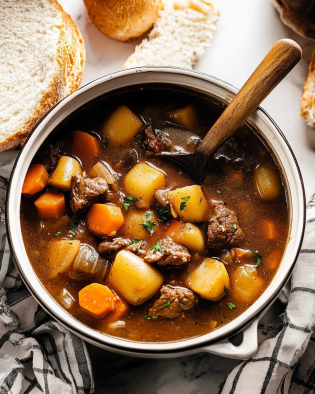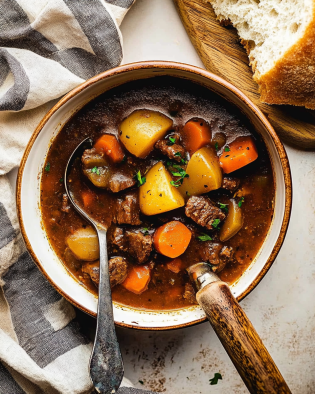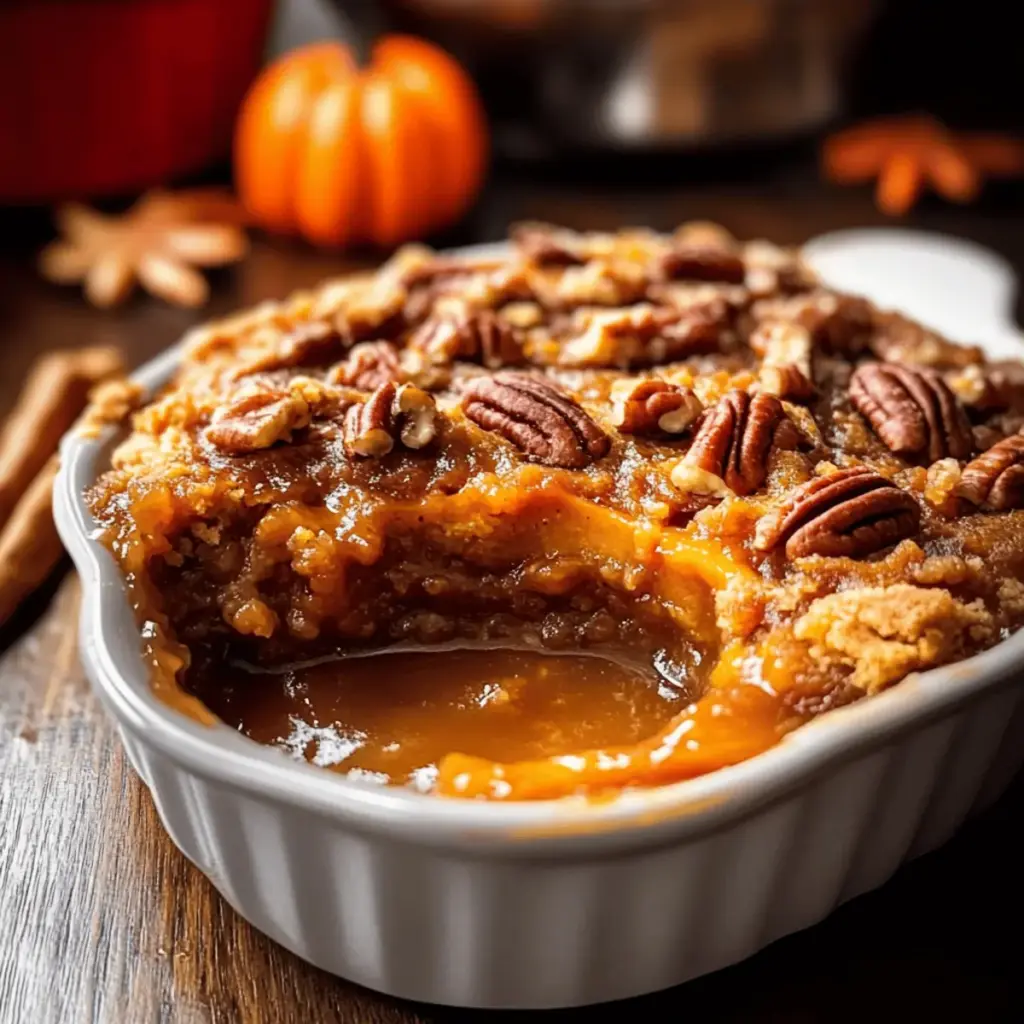
Introduction to Classic Beef Stew Recipe
The Comfort of Classic Beef Stew
There’s something truly special about a warm bowl of classic beef stew. This dish has been a favorite for generations, bringing comfort and joy to families around the world. The rich aroma of beef simmering with fresh vegetables fills the kitchen, creating a cozy atmosphere that invites everyone to gather around the table.
Classic beef stew is more than just a meal; it’s a heartwarming experience. The tender chunks of beef, combined with hearty vegetables, create a satisfying dish that warms you from the inside out. Whether it’s a chilly winter evening or a rainy day, this stew is the perfect remedy for the soul.
Moreover, the beauty of this classic beef stew recipe lies in its simplicity. With just a few ingredients, you can create a delicious and nutritious meal that your family will love. The slow cooking process allows the flavors to meld together beautifully, resulting in a dish that is both flavorful and filling.
As you embark on this culinary journey, you’ll discover that making classic beef stew is not only easy but also rewarding. Each step brings you closer to a delightful dish that showcases the essence of home-cooked comfort food. So, roll up your sleeves and get ready to create a classic beef stew that will surely become a staple in your kitchen!
Ingredients for Classic Beef Stew Recipe
To create a delicious classic beef stew, you’ll need a selection of fresh ingredients that come together to form a hearty and flavorful dish. Here’s what you’ll need:
- 2 pounds beef chuck: Cut into 1-inch cubes. This cut is perfect for stewing as it becomes tender and flavorful when cooked slowly.
- 1 tablespoon vegetable oil: Used for browning the beef, adding a nice sear and flavor.
- 1 medium onion: Chopped. Onions add sweetness and depth to the stew.
- 2 cloves garlic: Minced. Garlic enhances the overall flavor profile.
- 4 cups beef broth: This forms the base of your stew, providing richness and moisture.
- 2 cups carrots: Sliced. Carrots add sweetness and color to the dish.
- 2 cups potatoes: Diced. Potatoes make the stew hearty and filling.
- 1 cup celery: Sliced. Celery contributes a nice crunch and flavor.
- 1 teaspoon dried thyme: This herb adds a warm, earthy flavor.
- 1 teaspoon dried rosemary: Rosemary complements the beef beautifully.
- 2 bay leaves: These leaves infuse the stew with a subtle aroma.
- Salt and pepper: To taste. Essential for enhancing all the flavors.
- 2 tablespoons tomato paste: This adds a rich, tangy flavor and helps thicken the stew.
- 2 tablespoons all-purpose flour: Optional, for thickening the stew if desired.
Gathering these ingredients is the first step in your journey to making a classic beef stew. Each component plays a vital role in creating a dish that is not only delicious but also comforting. Feel free to adjust the quantities based on your preferences or dietary needs. Now that you have everything ready, let’s move on to the preparation!
Step-by-Step Preparation of Classic Beef Stew Recipe
Now that you have all your ingredients ready, it’s time to dive into the step-by-step preparation of your classic beef stew. Each step is crucial in building the rich flavors that make this dish so beloved. Let’s get started!
Step 1: Preparing the Ingredients
Before you begin cooking, it’s important to prepare all your ingredients. Start by washing and peeling the carrots and potatoes. Slice the carrots into rounds and dice the potatoes into bite-sized pieces. Next, chop the onion and mince the garlic. Having everything prepped and ready will make the cooking process smoother and more enjoyable.
Step 2: Browning the Beef
In a large pot or Dutch oven, heat the vegetable oil over medium-high heat. Once the oil is hot, add the beef cubes. Brown the beef on all sides, which should take about 5-7 minutes. This step is essential as it locks in the juices and adds a rich flavor to the stew. After browning, remove the beef from the pot and set it aside. This will allow you to sauté the vegetables in the same pot, capturing all those delicious flavors.
Step 3: Sautéing the Vegetables
With the beef set aside, it’s time to sauté the vegetables. In the same pot, add the chopped onion and minced garlic. Sauté them for about 3-4 minutes, or until the onion becomes translucent. This step enhances the flavor of the stew, as the onions and garlic release their natural sweetness. The aroma will fill your kitchen, making it hard to resist the anticipation of the meal to come!
Step 4: Combining Ingredients
Now it’s time to bring everything together. Return the browned beef to the pot with the sautéed onions and garlic. Stir in the beef broth, sliced carrots, diced potatoes, and sliced celery. Add the dried thyme, dried rosemary, bay leaves, salt, and pepper. Don’t forget to include the tomato paste, which adds a rich, tangy flavor. Stir everything well to combine, ensuring that the beef and vegetables are evenly coated with the broth and seasonings.
Step 5: Simmering the Stew
Bring the mixture to a boil over high heat. Once boiling, reduce the heat to low and cover the pot. Let the stew simmer for about 1.5 to 2 hours. This slow cooking process allows the beef to become tender and the flavors to meld beautifully. Stir occasionally to prevent sticking, and enjoy the delightful aroma wafting through your home. If you prefer a thicker stew, you can mix the flour with a little water to create a slurry and stir it in during the last 15 minutes of cooking.
After the simmering time, your classic beef stew will be ready to serve. Remove the bay leaves before serving, and taste to adjust the seasoning if necessary. Now, let’s explore some variations and tips to make your stew even more delightful!

Variation of Classic Beef Stew Recipe
While the classic beef stew recipe is a beloved favorite, there are many ways to put a personal twist on this dish. By experimenting with alternative ingredients and different cooking methods, you can create a version that suits your taste and lifestyle. Let’s explore some exciting variations!
Alternative Ingredients for Classic Beef Stew
One of the best things about classic beef stew is its versatility. You can easily swap out ingredients to suit your preferences or to use what you have on hand. Here are some alternative ingredients you might consider:
- Meat Options: Instead of beef chuck, try using lamb or pork for a different flavor profile. You can also use beef brisket for a richer taste.
- Vegetable Choices: Feel free to replace carrots and potatoes with other vegetables like parsnips, sweet potatoes, or green beans. Each vegetable adds its unique flavor and texture.
- Herbs and Spices: Experiment with fresh herbs like parsley or cilantro. You can also add a pinch of paprika or cayenne pepper for a little heat.
- Broth Variations: For a deeper flavor, consider using homemade beef broth or adding a splash of red wine to the broth. This can enhance the richness of the stew.
These alternative ingredients can help you create a classic beef stew that reflects your personal taste. Don’t hesitate to get creative and make it your own!
Different Cooking Methods for Classic Beef Stew
In addition to ingredient variations, you can also explore different cooking methods to prepare your classic beef stew. Here are a few popular options:
- Slow Cooker: For a hands-off approach, use a slow cooker. Simply brown the beef and sauté the vegetables, then transfer everything to the slow cooker. Cook on low for 6-8 hours or high for 3-4 hours. This method allows the flavors to develop beautifully.
- Pressure Cooker: If you’re short on time, a pressure cooker can significantly speed up the cooking process. Cook the stew on high pressure for about 35-40 minutes. The result will be tender beef and flavorful broth in a fraction of the time.
- Oven-Braised: After browning the beef and sautéing the vegetables, transfer everything to a Dutch oven and cover it. Bake in a preheated oven at 325°F (163°C) for about 2-3 hours. This method provides even heat and can enhance the flavors.
Each cooking method offers a unique way to enjoy classic beef stew. Choose the one that fits your schedule and cooking style best!
Cooking Note for Classic Beef Stew Recipe
When it comes to making a classic beef stew, a few cooking notes can help you achieve the best results. Understanding the cooking process and how to handle your ingredients can make a significant difference in flavor and texture. Here are some essential tips to keep in mind:
First, always choose the right cut of beef. Beef chuck is ideal for stewing because it has enough fat and connective tissue. This fat breaks down during cooking, making the meat tender and juicy. If you opt for leaner cuts, like sirloin, you may end up with tougher meat.
Next, don’t rush the browning process. Browning the beef is crucial as it develops a rich flavor through the Maillard reaction. Make sure your pot is hot enough before adding the beef. If the pot is overcrowded, the meat will steam instead of brown, so work in batches if necessary.
Additionally, consider the size of your vegetable pieces. Cutting them into uniform sizes ensures even cooking. If you prefer softer vegetables, you can add them at the beginning of the cooking process. For firmer vegetables, like green beans, add them later to maintain their texture.
Another important note is to avoid lifting the lid too often while the stew simmers. Each time you lift the lid, heat escapes, which can prolong cooking time. Instead, let the stew do its magic undisturbed, allowing the flavors to meld together beautifully.
Lastly, always taste your stew before serving. Adjust the seasoning as needed, adding more salt, pepper, or herbs to enhance the flavor. A well-seasoned stew will elevate the entire dish, making it even more enjoyable for everyone at the table.
By keeping these cooking notes in mind, you’ll be well on your way to creating a classic beef stew that is not only delicious but also a true comfort food masterpiece!
Serving Suggestions for Classic Beef Stew Recipe
Once your classic beef stew is ready, it’s time to think about how to serve it. The right accompaniments can elevate your meal and enhance the overall dining experience. Here are some delightful serving suggestions to consider:
- Crusty Bread: A warm, crusty loaf of bread is perfect for soaking up the rich broth. Consider serving a fresh baguette or homemade dinner rolls alongside your stew.
- Mashed Potatoes: For an extra comforting touch, serve your beef stew over a bed of creamy mashed potatoes. The potatoes will absorb the flavorful sauce, making each bite even more satisfying.
- Rice or Quinoa: If you prefer a lighter option, serve the stew over cooked rice or quinoa. These grains will add a nice texture and complement the hearty stew.
- Salad: A fresh green salad can provide a refreshing contrast to the warm stew. Consider a simple mixed greens salad with a light vinaigrette to balance the richness of the dish.
- Pickles or Relish: Adding a side of pickles or relish can introduce a tangy flavor that cuts through the richness of the stew. This can be a delightful surprise for your taste buds!
When serving classic beef stew, presentation matters too. Consider using deep bowls to showcase the stew’s vibrant colors and textures. Garnish with fresh herbs, like parsley or thyme, for a pop of color and added flavor.
Lastly, don’t forget to pair your meal with a suitable beverage. A glass of red wine, such as Cabernet Sauvignon or Merlot, complements the flavors of the beef stew beautifully. If you prefer non-alcoholic options, a sparkling water with a slice of lemon can be refreshing.
With these serving suggestions, your classic beef stew will not only be a comforting dish but also a delightful dining experience for you and your loved ones!
Tips for Perfecting Classic Beef Stew Recipe
Perfecting your classic beef stew is all about attention to detail and a few helpful tips. With these suggestions, you can elevate your stew to new heights, ensuring it’s not just good, but truly exceptional. Let’s dive into some key tips that will help you create a mouthwatering classic beef stew every time!
First, always start with high-quality ingredients. Fresh vegetables and good cuts of beef make a significant difference in flavor. Look for marbled beef chuck, as the fat will render down during cooking, adding richness to your stew. Fresh herbs will also enhance the taste, so opt for them when possible.
Next, don’t skip the browning step. This is crucial for developing deep flavors. Make sure your pot is hot enough before adding the beef. If you overcrowd the pot, the meat will steam instead of brown. Work in batches if necessary to achieve that perfect sear.
Consider marinating the beef beforehand. A simple marinade of red wine, garlic, and herbs can infuse the meat with flavor and tenderness. Allow the beef to marinate for at least an hour, or even overnight, for the best results.
When it comes to seasoning, be generous but taste as you go. Start with the basic salt and pepper, but feel free to add other spices like paprika or a dash of Worcestershire sauce for extra depth. Remember, you can always add more seasoning, but you can’t take it away!
Another tip is to let your stew cool before storing it. This helps prevent condensation from forming in the container, which can dilute the flavors. When reheating, do so gently on the stove to maintain the stew’s texture and taste.
Lastly, don’t rush the simmering process. Allowing the stew to cook low and slow is key to achieving tender meat and well-developed flavors. If you have the time, let it simmer for longer. The result will be a rich, hearty stew that everyone will love.
By following these tips, you’ll be well on your way to mastering the art of classic beef stew. Each batch will be a delightful experience, bringing warmth and comfort to your table!
Breakdown of Time for Classic Beef Stew Recipe
Prep Time
Preparing your ingredients is an essential step in making classic beef stew. The prep time typically takes about 15-20 minutes. During this time, you’ll wash and chop the vegetables, dice the beef, and measure out your spices. Having everything ready before you start cooking will make the process smoother and more enjoyable.
Cooking Time
The cooking time for classic beef stew is where the magic happens. Once you’ve browned the beef and sautéed the vegetables, the stew needs to simmer for about 1.5 to 2 hours. This slow cooking allows the flavors to meld together beautifully and ensures the beef becomes tender. If you choose to use a slow cooker or pressure cooker, the cooking times will vary, but the end result will still be delicious!
Total Time
In total, you can expect to spend around 2 to 2.5 hours from start to finish when making classic beef stew. This includes both the prep and cooking times. While it may seem like a lengthy process, the wonderful aroma and comforting flavors that fill your home are well worth the wait. Plus, the stew can be made in advance and stored for later, making it a perfect meal for busy days!
Nutritional Information for Classic Beef Stew Recipe
Understanding the nutritional content of your classic beef stew is essential for making informed choices about your meals. This hearty dish not only satisfies your hunger but also provides a good balance of nutrients. Let’s break down the nutritional information for a serving of classic beef stew.
Calories in Classic Beef Stew Recipe
Each serving of classic beef stew contains approximately 350 calories. This makes it a filling option for lunch or dinner. The combination of beef, vegetables, and broth creates a satisfying meal that can keep you energized throughout the day. If you’re watching your calorie intake, consider pairing the stew with a light salad or some steamed vegetables to balance your meal.
Protein Content in Classic Beef Stew Recipe
One of the standout features of classic beef stew is its protein content. Each serving provides about 30 grams of protein. This is primarily due to the beef, which is an excellent source of high-quality protein. Protein is essential for muscle repair and growth, making this stew a great option for those looking to maintain a healthy diet.
Sodium Levels in Classic Beef Stew Recipe
The sodium levels in classic beef stew can vary based on the ingredients used, particularly the beef broth. On average, a serving contains around 800-900 milligrams of sodium. If you’re concerned about sodium intake, consider using low-sodium beef broth or making your own broth at home. This way, you can control the amount of salt in your stew while still enjoying its rich flavors.
Overall, classic beef stew is a nutritious and hearty meal that can fit well into a balanced diet. With its combination of protein, vitamins, and minerals from the vegetables, it’s a dish that not only warms the heart but also nourishes the body!

FAQs about Classic Beef Stew Recipe
What type of beef is best for Classic Beef Stew?
When it comes to making classic beef stew, the best cut of beef is beef chuck. This cut is well-marbled with fat, which breaks down during cooking, making the meat tender and flavorful. Other good options include brisket or round, but avoid lean cuts like sirloin, as they can become tough when stewed. Choosing the right cut is key to achieving that melt-in-your-mouth texture that everyone loves in a hearty stew.
Can I make Classic Beef Stew in a slow cooker?
Absolutely! A slow cooker is a fantastic way to prepare classic beef stew. Simply brown the beef and sauté the vegetables as directed, then transfer everything to the slow cooker. Cook on low for 6-8 hours or on high for 3-4 hours. This method allows the flavors to develop beautifully while you go about your day. Just remember to adjust the liquid if needed, as slow cookers can retain moisture better than traditional stovetop cooking.
How long can I store Classic Beef Stew?
You can store classic beef stew in the refrigerator for up to 3-4 days. Make sure to let it cool completely before transferring it to an airtight container. If you want to keep it longer, consider freezing it. Classic beef stew can be frozen for up to 3 months. When you’re ready to enjoy it again, simply thaw it in the refrigerator overnight and reheat on the stove until warmed through. This makes it a great make-ahead meal!
What can I serve with Classic Beef Stew?
Classic beef stew pairs wonderfully with a variety of sides. Consider serving it with crusty bread or dinner rolls to soak up the delicious broth. Mashed potatoes or rice are also great options, as they complement the stew’s hearty flavors. For a lighter touch, a fresh green salad can provide a nice contrast. You can even add pickles or a tangy relish on the side for an extra burst of flavor. The possibilities are endless!
Conclusion on Classic Beef Stew Recipe
In conclusion, the classic beef stew recipe is a timeless dish that brings warmth and comfort to any table. With its rich flavors and hearty ingredients, it’s no wonder this stew has been a family favorite for generations. The process of making it, from browning the beef to simmering the vegetables, creates a delightful experience that fills your home with mouthwatering aromas.
As you’ve learned, this recipe is not only simple but also versatile. You can easily customize it with different meats, vegetables, and cooking methods to suit your taste. Whether you choose to make it on the stovetop, in a slow cooker, or even in a pressure cooker, the result will always be a delicious and satisfying meal.
Moreover, classic beef stew is a nutritious option that provides a good balance of protein, vitamins, and minerals. It’s perfect for family dinners, gatherings, or even meal prep for busy weeks ahead. With a few thoughtful tips and variations, you can elevate your stew to new heights, ensuring it’s a dish everyone will love.
So, gather your ingredients, roll up your sleeves, and embark on this culinary adventure. Your classic beef stew awaits, ready to warm hearts and fill bellies. Enjoy every bite, and don’t forget to share this comforting dish with your loved ones. Happy cooking!







